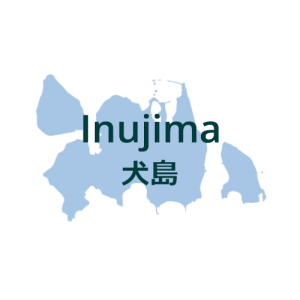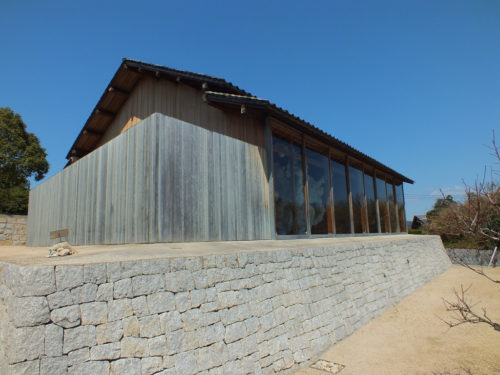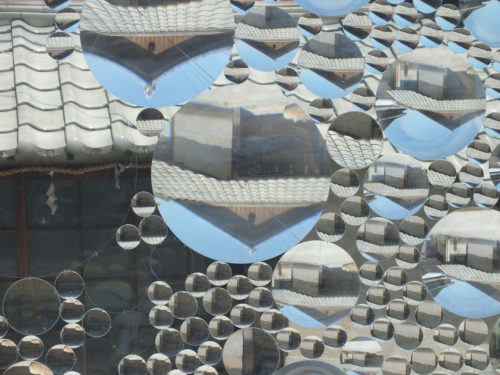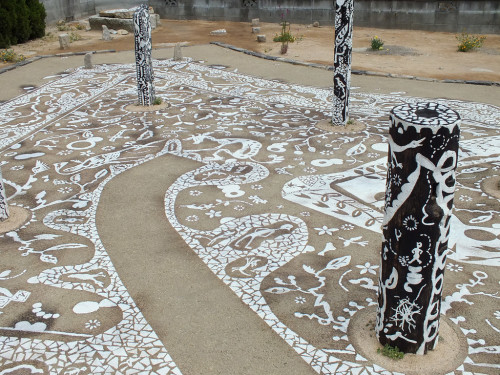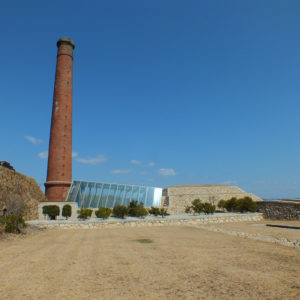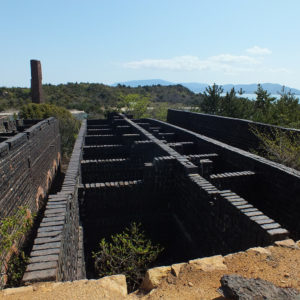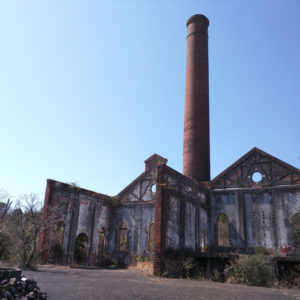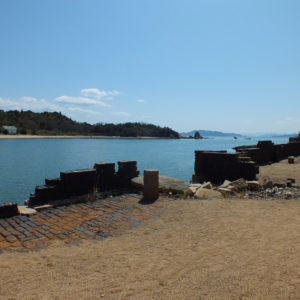Inujima is the only Art Setouchi island that is not located in Kagawa Prefecture, but in Okayama Prefecture. It’s also one of the three islands that are managed by Benesse Art Site Naoshima (the other two being Naoshima and Teshima).
During the Edo period, just like a certain number of its neighbors, Inujima was renowned for its quarries that provided stones for many castles of the time, including Okayama, Osaka, and Edo. Remains of these quarries are still present on this island, as nowadays one can find a certain number of “holes” all over the island that are filled with water and have become ponds where hills once stood. This is unfortunately not the only abuse that nature was going to suffer on the island. In 1909, at the height of Japan’s industrialization, a copper refinery opened on Inujima. Despite only staying open for a decade or so, the island’s population grew up to 5,000 residents (there are less than 50 nowadays), and the refinery caused major pollution on the island, traces of which can still be found a century later. The ruins of this refinery still occupy a large portion of the tiny island and are now part of the large-scale art project known as the Seirensho Art Museum.
- Land area: 0,54 km2
- Circumference: 3,6 km
- Highest point: 36 m
- Population: 40 (only 28 reside permanently on the island)
Getting there
Inujima is not always easy to reach, especially outside of the Setouchi Triennale. The two main access routes are either from Naoshima or Teshima (it’s the same boat) or from Hoden port in Okayama Prefecture. Please note that the ferry from the neighboring islands does not run on days when artworks are closed (usually Tuesdays).
During the Setouchi Triennale, there are a certain number of extra ferries from Shodoshima and a couple of ports in Okayama (Kyobashi and Ushimado ports) that run.
May I advise you to check out the official website for a full list of ferries and timetables.
Getting around the island
The island is very small and mostly flat. Unless you have trouble walking, this is what you should do when visiting the island. It’s not like you have other options anyway (maybe you can bring a bicycle on some boats, not sure).
More
For more information about Inujima, feel free to check out Hinomaple’s Guide:
Artworks
Generally speaking and unless stated otherwise, art on Inujima is available every day but Tuesdays. However, when a holiday falls on a Tuesday, things will be open on that day but will be closed on the next regular day (that is on Wednesday unless it’s a holiday too). In Winter, art is only open from Friday to Monday included, as well as on holidays.
All artworks are accessible with a single ticket that will cost you 2,060 yen and that you can buy at the Welcoming and Information Center on the island. It’s the big black building on your left once you’ve set foot on the island. Access is free for minors under the age of 16.
During the Setouchi Triennale, artworks are accessible to Triennale Passports holders.
Note that pictures are not allowed inside a lot of the buildings that have art, hence their scarcity on this site.
You can read the posts talking about Inujima on this site after clicking on this link.
Art on Inujima
in01-B
Inujima Art House Project / F – Art House: Biota (Fauna / Flora)
Artist: Kohei Nawa – Architect: Kazuyo Sejima (2013)
- Open from 10 am to 4.30 pm (last entrance at 4 pm)
- Kohei Nawa online: official site (in English and Japanese)
Review: Nice, but not mindblowing.
⭐⭐⭐
Inujima Art House Project / S – Art House: Contact Lens
Artist: Haruka Kojin – Architect: Kazuyo Sejima (2013)
- Outdoor artwork, always accessible
Review: Very beautiful. The landscape (cityscape? villagescape?) changes and becomes a bit surreal as you walk and look through the lenses.
⭐⭐⭐⭐
in03-B
Inujima Art House Project / A – Art House: Yellow Flower Dream
Artist: Beatriz Milhazes (2018) – Architect: Kazuyo Sejima (2013)
- Outdoor artwork, always accessible
Review: this art space is a big transparent circle that you can enter. Artworks are usually inside the circle and can be seen from the inside and from the outside. I haven’t seen the latest one yet.
in04-B
Inujima Art House Project / C – Art House: new art from the Summer session.
Artist: Masanori Handa (2019) – Architect: Kazuyo Sejima (2013)
- Open from 10 am to 4.30 pm (last entrance at 4 pm)
Set to open for the summer session of the Setouchi Triennale
in05-B
Inujima Art House Project / I – Art House: Self Loop
Artist: Olafur Eliasson – Architect: Kazuyo Sejima (2016)
- Open from 10 am to 4.30 pm (last entrance at 4 pm)
- Olafur Eliason online: official site
Review: Meh. Just a few mirrors facing each other. I’m OK with having a very liberal definition of “art”, but that’s really stretching it.
⭐
in06-B
Inujima Art House Project – Former site of a Stonecutter’s House: Listen to the Voices of Yesterday Like the Voices of Ancient Times
Yusuke Asai and Yuko Hasegawa (2013, 2016)
- Outdoor artwork, always accessible
- Yusuke Asai online: Twitter
- On the blog
- Note: since 2016, the artwork has grown beyond its original site. Some parts can now be found when you walk by the sea, between Art House I and the port.
Review: I really like this place. It feels like it had been taken over by some Australian aborigines who would have painted it. It really looks like an ancient site for magic rituals or something like this.
⭐⭐⭐⭐
in07-B
Inujima Seirensho Art Museum
Yukinori Yanagi and Hiroshi Sambuichi (2008)
- Open from 10 am to 4.30 pm (last entrance at 4 pm)
- Yukinori Yanagi online: official site (in English and Japanese)
Review: Probably one of the Art Setouchi artworks that shouldn’t be missed. If you can, try to avoid the crowds when visiting it. Yukinori Yanagi’s art needs to be seen with a minimal amount of people walking with you (or rather before and after you) in the long corridor that is the first part of his giant installation.
Also, when you visit the ruins of the copper refinery, make sure to follow all the safety warnings. They’re not there to annoy you, but to prevent accidents.
⭐⭐⭐⭐⭐
in08-B
Nakanotani Gazebo
Kazuyo Sejima
- Outdoor artwork, always accessible
Review: the place is supposed to be a rest area, but I find the echo under the parabolic roof to be very unpleasant when you’re underneath, and the chairs are quite uncomfortable. It’s a shame because it looks nice otherwise.
⭐
in09-B
Inujima Life Garden
Kazuyo Sejima (2016)
- Outdoor artwork, always accessible
Review: A very beautiful garden and greenhouse. Now, when I saw it, it wasn’t completely finished yet. I’m hearing that now it looks much more interesting.
⭐⭐⭐⭐
Note that on your way to the garden you’ll walk by an interesting building called Inujima House Project. It’s not affiliated with Art Setouchi, but it’s very interesting nonetheless. In case you’re wondering, Inujima means dog island.
Finally, I’ll end with this post from Andrew McCormick who studies the Benesse Islands and wrote one of the finest pieces I have read about Inujima.
Discover more from Setouchi Explorer
Subscribe to get the latest posts sent to your email.
